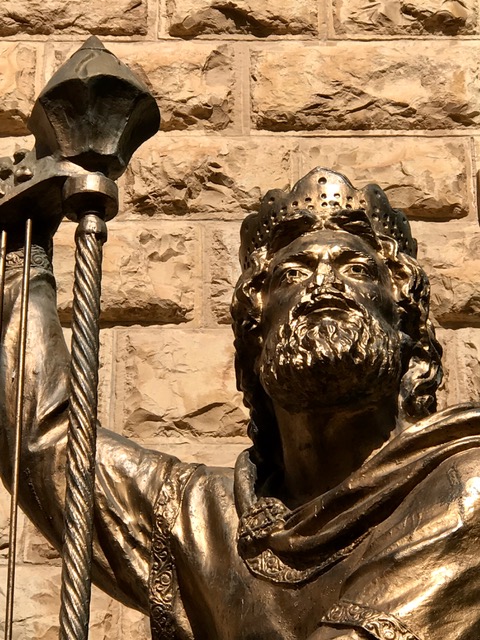Surely your goodness and love will follow me all the days of my life,
and I will dwell in the House of the Lord forever.
Psalm 23:4 A Psalm of David
Mount Zion
Mount Zion has referred to three different locations; firstly, the City of David, and then Mount Moriah. Today's location on the (south) Western Hill outside of Jerusalem's Old City is shown on the map below,
Important sites on Mount Zion are King David's tomb (although most historians do not consider this the actual burial spot) and the Room of the Last Supper
Jerusalem's Old City
From Wikipedia
From Wikipedia
King David's Tomb
The Bible tells us that Saul, Israel's King, angered God with his disobedience. God sent the prophet Samuel to anoint David as the new King of Israel. David cemented his relationships with other political and national groups through marriage to eight wives, and ruled over a kingdom of some size. He was able to conquer the Canaanite city of Jerusalem. King David is one of the most important figures in Jewish history, reigning as King of Israel for 40 years. His hereditary bloodline is the only legitimate royal bloodline in Jewish history. From David will come all the future kings of Judah, and ultimately, the Messiah.
King David and his harp
Synagogues generally don't have statues as a statue may be considered an idol which is forbidden by one of the Ten Commandants that says, "Thou shalt have no other Gods before me". So why is there a modern statue of David outside his tomb? Much debate in the Jewish community as to the appropiateness of a statue of King David led to the decision that if a statue doesn't have a nose it's not an idol.
Entering the room that houses David's Tomb
Top of King David's tomb (with plastic covering)
Inside David's tomb is a small synagogue
The Torah is housed here
Even Orthodox Jews are interrupted during prayers by cell phone calls like everyone else, it seems. Perhaps his wife just had a baby. Ultra-orthodox Jews welcome large families of 8-10 children. The box on his forehead is called a tefillin. Also called phylacteries, a forehead tefillin and a arm tefilin (not seen) are worn by an observant Jewish male for weekday morning prayers. The tefillin boxes contain small scrolls of parchment inscribed with verses from the Torah.
Room of the Last Supper
Mount Zion is also the location of the upper room traditionally believed to be the site where Jesus and his disciples conducted the Passover meal - The Last Supper. The room is unremarkable except to several features.
According to Luke 22: 7-23, while they were eating, Jesus took bread, gave thanks and broke it, and gave it to his disciples, saying, "Take and eat; this is my body". It is suggested that the unusual capital of the column seen above is a depiction of Christian communion.
"Take and eat; this is my body"
Two baby birds are "eating" the body of the mother bird (center), some believe
A Byzantine church, a Crusader church and a mosque were built sucessively on this site. The room in its present shape was built in the 14th Century. During the Ottoman rule, when it was converted into a mosque, a prayer niche (Mihrab), dedicated to King David was carved into its southern wall.
Window with arabic script
Mihrab or prayer niche, which orients Muslims toward the East for prayer













No comments:
Post a Comment